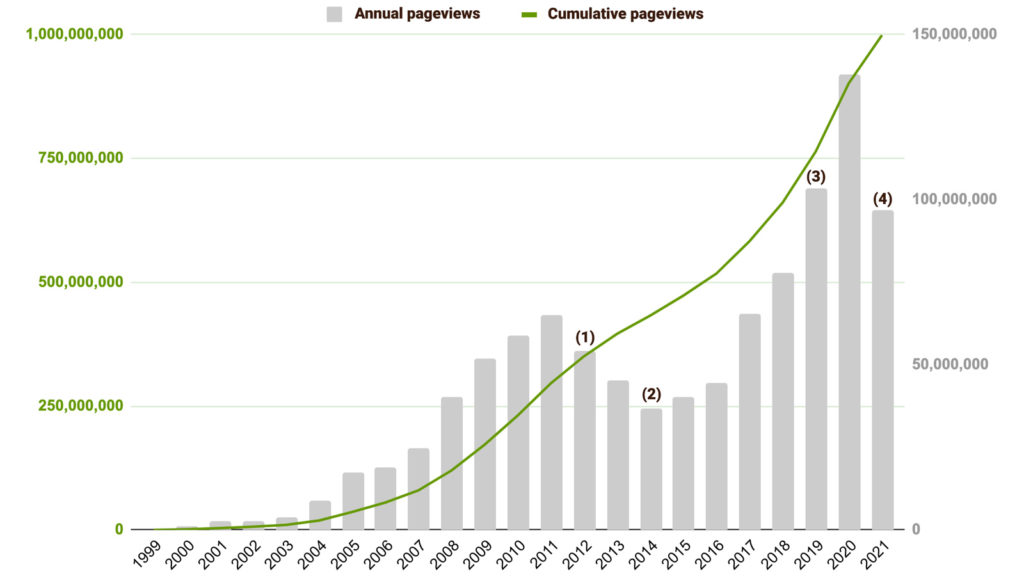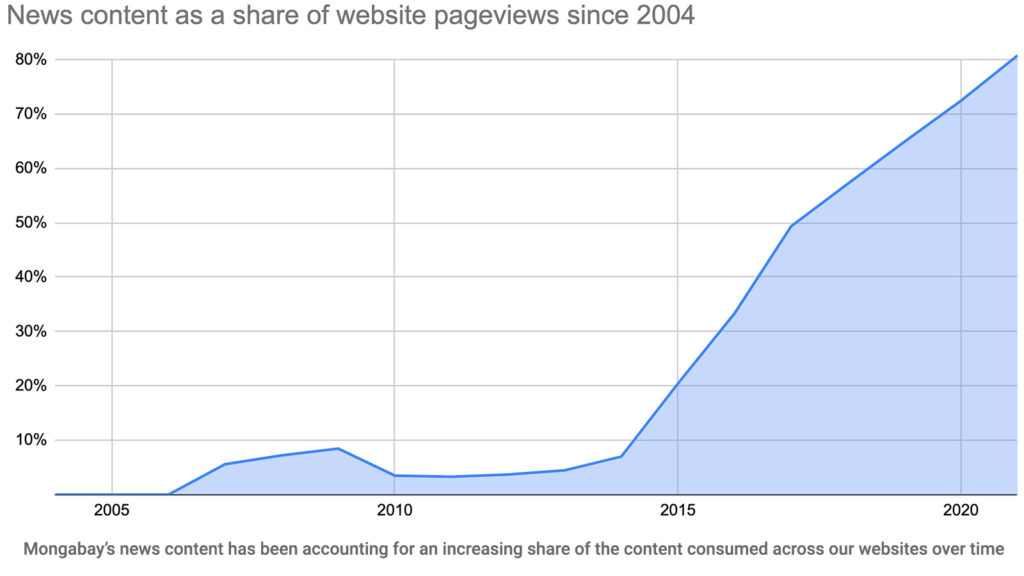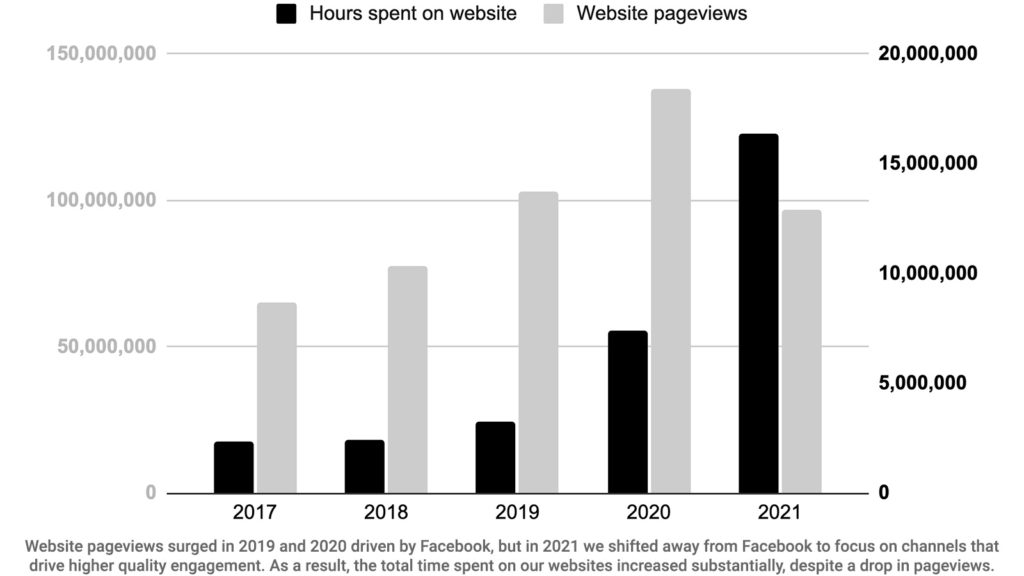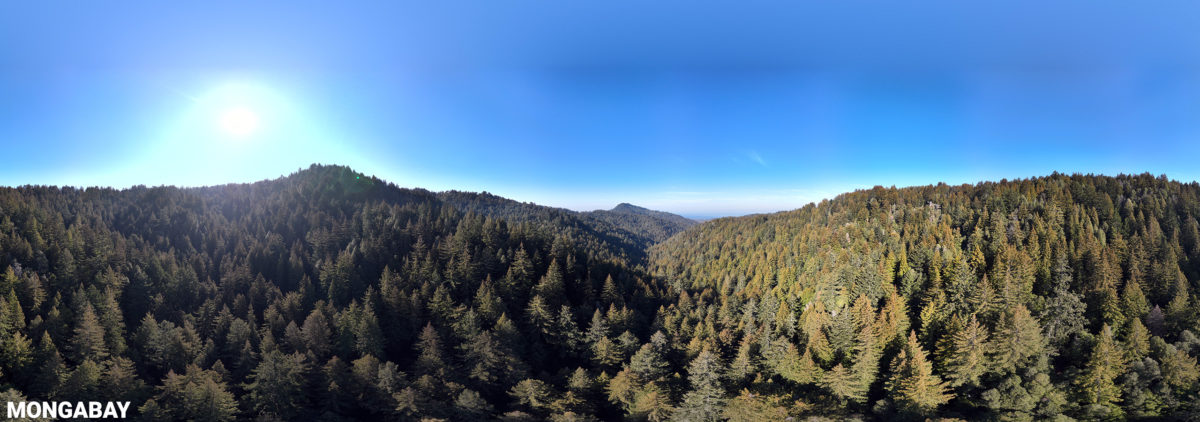Mongabay just hit 1 billion lifetime pageviews. It took almost 23 years. Here’s my key takeaway from the journey.

Pageviews on our websites are just one indicator of our reach, and one that is diminishing in importance as more of our content is distributed via other channels like app-based platforms, social media, third party distribution/syndication, video, and podcasts. Pageviews also don’t capture the quality of engagement–for that, Mongabay uses other metrics like time spent on our articles.
Readership of our content outside our websites has been accounting for a growing share of traffic since 2016. That readership is not captured in the chart.
A few events are called out on the chart:
(1) Google changes image search, reducing traffic to Mongabay nature photo section by 99% within three years.
(2) Google stops recognizing Mongabay as the original source of our own news articles, likely due to widespread syndication of our content by other outlets and news scraping sites. Getting Google to address the issue takes nearly three years.
(3) Peak Facebook traffic, when referrals Facebook sometimes exceeded 70% of external referral traffic
(4) Mongabay reduces its level of effort on Facebook, including abandoning Facebook marketing, for most of its bureaus.
One billion pageviews is a small number compared with platforms like YouTube and Facebook or mainstream news outlets like The New York Times, but for a niche provider of environmental news like Mongabay, the interest in our content has far surpassed my wildest dreams.
When I started Mongabay, there wasn’t a business model.
In fact, there was no “business” at all: The sole purpose of Mongabay was to be a source of information on tropical rainforests. Mongabay was a labor of love that I sank time and money into without any expectation of ever seeing any money. I relied on a “real job”–and thrifty living–to pay the bills.
But as Mongabay grew in popularity, I saw opportunities to expand its scope and impact, while also creating the potential to earn an income through advertising and selling my photos.
That approach however had to evolve as the market changed and my level of ambition for the website grew.

Today Mongabay’s model is completely different: it is a non-profit organization that relies on grants and reader support. Advertising revenue is negligible. Mongabay also employs more than 70 staff in over 20 countries and last year worked with about 800 contributing journalists. It’s a far cry from when it was just me in my apartment.
But while Mongabay’s business model has changed over time, our core business has not: Our primary focus remains producing high quality original content and making it accessible to as many people as we can. It’s a simple approach, but success requires the ability to adapt in response to change.
For example, in the late 1990s Mongabay’s content was nearly entirely text-based. In the early 2000s, as bandwidth improved, photos got more emphasis. Then came social media platforms, video, and podcasts, each of which have evolved substantially over very short-time frames. What’s next? Maybe it will be immersive environments like augmented reality or virtual reality platforms–e.g. the metaverse.

The total number of hours spent on our websites in 2021 was more than the combined figure for 2017, 2018, 2019, and 2020, reflecting strong growth in engagement last year. While we’re only a month-and-a-half into 2022, we’re seeing a continuation of that trend.
But no matter the platform or format, we’ll continue to embrace the core idea that high quality original content can draw an audience.
For us, this matters because we believe that addressing critical environmental challenges requires access to more actionable information, communicated in a timely manner across multiple languages and platforms to reach the audiences that shape policy and influence global trends supportive of a sustainable future.
Thanks to everyone who got us to our first billion website pageviews. If you’d like to help us get to our next billion, check out Mongabay’s website. We’re also on social media.

